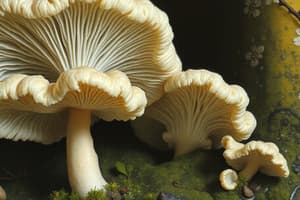Podcast
Questions and Answers
What is the function of trichogynes in the reproduction of fungi?
What is the function of trichogynes in the reproduction of fungi?
- They generate mycelium from haploid nuclei.
- They produce asexual spores.
- They form the vegetative body of the fungus.
- They serve as receptive filaments for fertilization. (correct)
What occurs during the meiosis phase of zygote development in fungi?
What occurs during the meiosis phase of zygote development in fungi?
- One diploid zygote divides into four haploid nuclei. (correct)
- Eight haploid nuclei are produced immediately.
- Four diploid zygotes are formed from the original zygote.
- Only two haploid nuclei are formed from the zygote.
In which type of fungi are ascospores arranged in a specific order within the ascus?
In which type of fungi are ascospores arranged in a specific order within the ascus?
- Aspergillus
- Neurospora (correct)
- Mucor
- Yeast
What is the result of first-division segregation in tetrad analysis?
What is the result of first-division segregation in tetrad analysis?
What does tetrad analysis allow researchers to do in fungi?
What does tetrad analysis allow researchers to do in fungi?
What characteristic differentiates the organization of ascospores in yeast from that in Neurospora?
What characteristic differentiates the organization of ascospores in yeast from that in Neurospora?
How is a heterokaryon formed in fungi?
How is a heterokaryon formed in fungi?
What structure contains the mature ascospores in fungi?
What structure contains the mature ascospores in fungi?
What does a 4:4 ratio of ascospores indicate in the context of first-division segregation?
What does a 4:4 ratio of ascospores indicate in the context of first-division segregation?
When examining second-division segregation, what pattern is indicative of crossing over between the gene and its centromere?
When examining second-division segregation, what pattern is indicative of crossing over between the gene and its centromere?
What is the significance of the distance between a gene locus and the centromere in the context of crossing over?
What is the significance of the distance between a gene locus and the centromere in the context of crossing over?
Which of the following is NOT a characteristic of the organism Neurospora crassa in genetic research?
Which of the following is NOT a characteristic of the organism Neurospora crassa in genetic research?
What happens to chromatids during second meiotic anaphase in the case of second-division segregation?
What happens to chromatids during second meiotic anaphase in the case of second-division segregation?
Why is Neurospora considered a model organism for studying DNA methylation?
Why is Neurospora considered a model organism for studying DNA methylation?
What does a linear ratio of 4:4 in ascospores during first-division segregation imply about the genetic configuration?
What does a linear ratio of 4:4 in ascospores during first-division segregation imply about the genetic configuration?
Which aspect of N.crassa simplifies genetic analysis when studying recessive traits?
Which aspect of N.crassa simplifies genetic analysis when studying recessive traits?
Flashcards are hidden until you start studying
Study Notes
Neurospora crassa: A Model Organism for Genetics
- Neurospora crassa serves as a model organism for genetics, with a haploid life cycle.
- Neurospora`s haploid stage simplifies genetic analysis, making recessive traits readily observable.
- Haploid nuclei in hyphae (filaments) of different mycelia can be combined in a heterokaryon.
- Sexual reproduction occurs between different mating types, regulated by the A and a alleles.
- Fertilization results from a conidium or hypha from the opposite mating type fusing with a trichogyne.
- The zygote undergoes meiosis within an elongated sac called the ascus.
- The arrangement of ascospores within the ascus allows for tetrad analysis, studying the products of a single meiotic event.
- Tetrad analysis reveals two distinct linear ratios for segregating alleles:
- 4:4 ratio: First-division segregation, indicating no crossing over between the gene and its centromere.
- 2:2:2:2 ratio: Second-division segregation, indicating crossing over between the gene and its centromere.
- The closer a gene is to the centromere, the less likely crossing over is, increasing the observation of a 4:4 ratio.
- Crossing over in meiotic prophase leads to the attachment of a non-sister chromatid to the same centromere.
- Separation of sister chromatids during second anaphase leads to the 2:2:2:2 pattern observed in second-division segregation.
Neurospora's Importance in Genetics Research
- Easy cultivation with simple nutritional requirements makes Neurospora a valuable model organism.
- Ordered arrangement of ascospores facilitates the analysis of genetic recombination.
- Susceptibility to mutagenesis enables the investigation of genetic changes.
- The sequenced genome provides a comprehensive understanding of its genetic makeup.
- Neurospora has contributed to the elucidation of molecular events in various areas, including:
- Circadian rhythms
- Epigenetics and Gene silencing
- Cell polarity
- Cell fusion and development
- DNA Methylation and Silencing
- Recombination
- DNA Repair
- Differentiation
- Morphogenesis
- Cell Biology
Studying That Suits You
Use AI to generate personalized quizzes and flashcards to suit your learning preferences.



